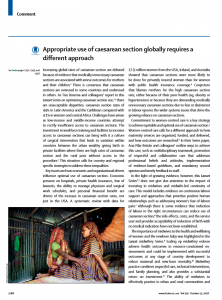
Increasing global rates of caesarean section are debated because of evidence that medically unnecessary caesarean sections are associated with worse outcomes for mothers and their children. There is consensus that caesarean sections are overused in some countries and underused in others. As Ties Boerma and colleagues report in this Lancet Series on optimising caesarean section use, there are unacceptable disparities: caesarean section rates of 44% in Latin America and the Caribbean compared with 4·1% in western and central Africa. Challenges have arisen as low-income and middle-income countries attempt to rectify insufficient access to caesarean sections. The investment in workforce training and facilities to increase access to caesarean sections can bring with it a culture of surgical intervention that leads to variation within countries between the urban wealthy giving birth in private facilities where there are high rates of caesarean section and the rural poor without access to the procedure. This situation calls for country and regional specific strategies to address these inequalities.
Key issues are how economic and organisational drivers influence optimal use of caesarean section. Economic pressure on hospitals, private health insurance, fear of lawsuits, the ability to manage physician and surgical work schedules, and personal financial benefit are drivers of the increase in caesarean section rates, not just in the USA. A systematic review with data for 12·9 million women from the USA, Ireland, and Australia showed that caesarean sections were more likely to be done for privately insured women than for women with public health insurance coverage. Conjecture that blames mothers for the high caesarean section rate, either because of their poor health (eg, obesity or hypertension) or because they are demanding medically unnecessary caesarean sections due to fear or disinterest in labour ignores the wider systems issues that drive the growing reliance on caesarean sections.
—
Caesarean section—the most common surgery in many countries around the world—is a procedure that can save women’s and babies’ lives when complications occur during pregnancy or birth. However, caesarean section use for non-medically indicated reasons is a cause for concern because the procedure is associated with considerable short-term and long-term effects and health-care costs. Caesarean section use has increased over the past 30 years in excess of the 10–15% of births considered optimal, and without significant maternal or perinatal benefits. A three-part Lancet Series on Optimising Caesarean Section Use reviews the global epidemiology and disparities in caesarean section use, as well as the health effects for women and children, and lays out evidence-based interventions and actions to reduce unnecessary caesarean sections.
Access the 1st paper of the Lancet series – Global epidemiology of use of and disparities in caesarean sections
Access the 2nd paper of the Lancet Series – Short-term and long-term effects of caesarean section on the health of women and children
Access the 3rd paper of the Lancet Series – Interventions to reduce unnecessary caesarean sections in healthy women and babies
Access the 1st Comments paper about the series – FIGO position paper: how to stop the caesarean section epidemic
Access the 3rd Comments paper about the series – Strategic measures to reduce the caesarean section rate in Brazil
Access the Editorial paper about the series – Stemming the global caesarean section epidemic
Access the Profile paper related to the series – Ana Pilar Betrán: seeking the optimum use of caesarean section